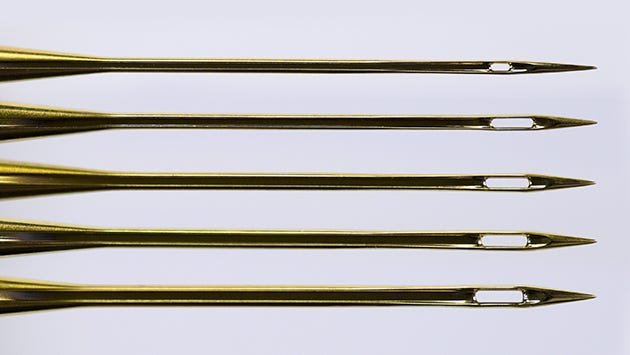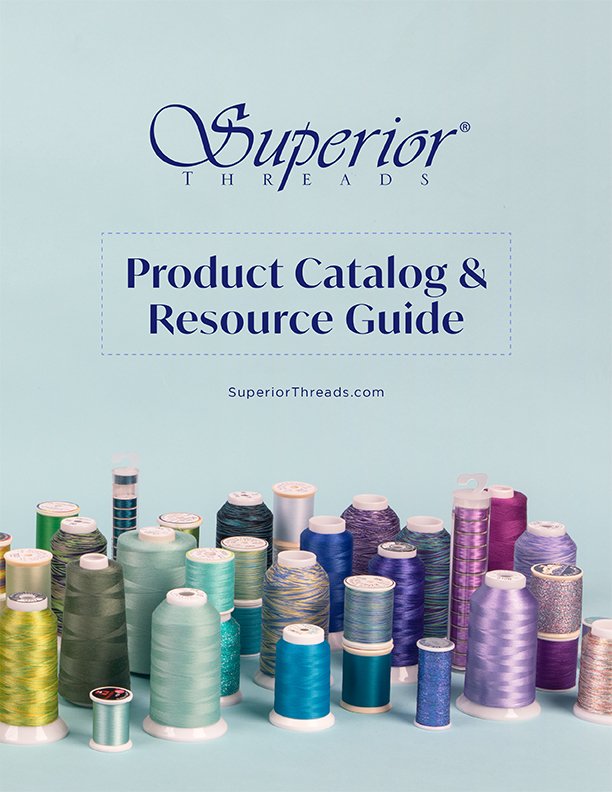Superior Education
NEEDLE GUIDE
- NEEDLES
- TOPSTITCH
- TITANIUM COATED
Using the right needle
One of the most significant parts of today's home machines is often the least appreciated and most obscure - the needle. A sewing machine needle is a slender strand of metal, shaped to precision, which delivers thread to the machine to create a stitch. We spend thousands of dollars on the most advanced machines, acquire the best digitized designs, use the most lustrous thread, and the most beautiful fabric to produce our projects. But all too often this is all for naught because we either use an old, worn, damaged needle or we use the wrong needle for the fabric. Needles can be damaged by normal use. You don't have to hit a pin while sewing to damage your needle. They can become dull, bent, damaged or get misshapen eyes through normal sewing. All these contribute to frustrating thread breaks and a frayed look on your finished projects. The best advice we can give is this: When you start a new project, start with a new needle. It's the least expensive part of a superior finished project. Overall, a clean, well functioning needle will result in sharp, well-shaped stitches. Needles are inexpensive and easy to change. Keeping a good needle in your sewing machine is one of the easiest, least expensive ways to improve your embroidery and sewing projects.
Needle Points
Needles fall into three primary categories -- ball point, sharp, and rounded-sharp. It is important to use the correct needle. Ball point needles are designed to avoid making holes in knit or loosely woven materials. The cross fibers which constitute the knit or loosely woven materials are relatively far apart as compared to those in tightly woven materials. If a knit strand of thread is cut with a sharp needle, it produces a hole that will enlarge when the loose fibers pull back from the cut. To prevent this, the ball point needle is designed to push aside the individual strands of the knit. This assumes that the ball point needle point is in good condition. Sharp needles are designed for woven fabrics. Because of the tightness of the weave, individual cut fibers will not pull away and make holes. For this exact reason it is important not to use ball point needles on wovens. The blunt force of a ball point will tear through the fibers and actually pull them in the process, resulting in uneven, irregular embroidery and damage to the fabric. Sharp needles can be used on all wovens as well as dense fabrics such as leather, vinyl, canvas, etc.

Superior's titanium-coated needles. Size #60 (top) to size #100 (bottom)

The difference between a Universal needle (top) and Topstitch needle (bottom)
Needle Sizes
Needles range in size from very fine 55/7 to a heavy duty needle 120/19. Most needles use the two-number measuring system. The higher number relates to the metric system and defines the needle shaft diameter in hundredths of a millimeter. The lower number relates to the system in the U.S. and is an arbitrary number also used to indicate needle shaft diameter. View our educational diagram about needle sizes.
Needle Styles
Ballpoint
The ballpoint needle has a rounded point of varying degrees. Its primary application is to sew on knit type fabrics. The rounded tip slips between yarns rather than cutting them. This prevents broken fibers and the attendant unraveling.
Denim
The denim (jeans) needle has a very sharp, acute point with a slender eye and a strong shaft. The sharp point is necessary to penetrate heavy fabrics like denim and canvas. The slender eye holds the thread in place for proper loop formation. The strong shaft prevents deflection of the needle and insures accurate needle placement for stitch formation.
Embroidery
The embroidery needle has a sharp point, a large eye and a special scarf to protect specialized decorative threads in embroidery. It also has a shorter point-to-eye length to enhance embroidery applications by ensuring extra clearance between the needle point and the embroidered article as it moves for succeeding stitches.
Leather
The leather needle has a wedge shaped point which gives it the piercing strength it needs to penetrate heavy fabrics like leather and vinyl. The needle makes a very clean hole in the fabric, so mistakes are costly.
Metallic
The Metallic needle is specifically designed for metallic threads. It has a large, elongated Teflon coated eye, larger scarf and a larger groove to protect the more fragile metallic threads during stitch formation.
Microtex
This needle is sharper than the universal point with a more slender shaft. It is used primarily on fine wovens and for heirloom sewing on very fine fabrics and for synthetic suede.
Quilting
The quilting needle has a tapered point for stitching through multiple layers and across seams. The shape of the point minimizes damage to the quilting fabric.
Topstitch
The topstitch needle has an extra large eye and a much deeper groove for use with either heavier fabrics and/or heavier threads. It can even accommodate doubling of threads for more pronounced stitching.

 View Our Product Catalog
View Our Product Catalog